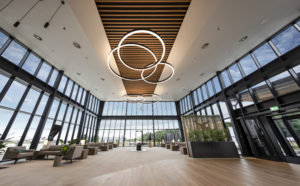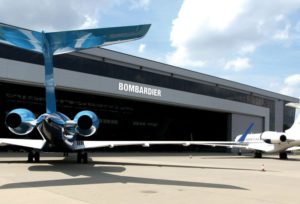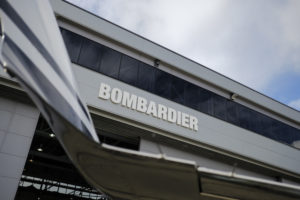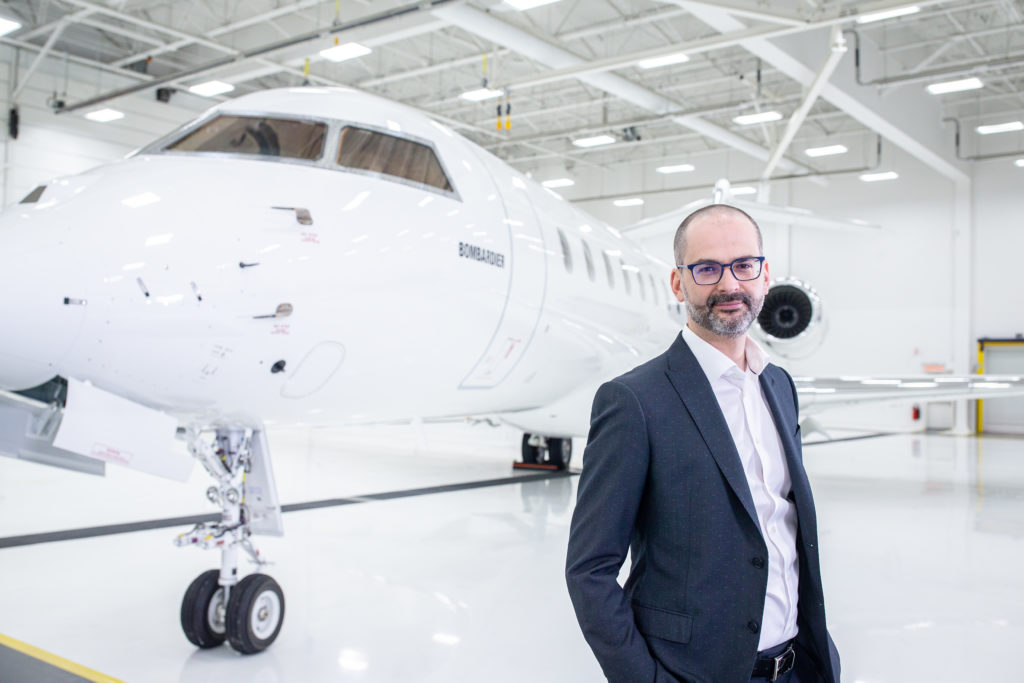Jean-Christophe Gallagher joined Bombardier 20 years ago as an engineer in advanced product development. Today he is the executive vice president of services and support and corporate strategy. He has held various positions in the company and is best-known for being behind Bombardiers’ successful “Bring Our Jets Home” MRO marketing campaign.
At the grand opening of Bombardier’s new London Biggin Hill Service Centre, BAI talked to Gallagher about his career so far, how important the expansion at the London airport is to the business jet maker and why he feels so passionately about sustainability in aviation and bringing jets home.
What was your path to your current role?
I’m an engineer by trade and joined the company in 2002. I spent my first years at Bombardier within the advanced design group, which works on all of the future products of the company. It got me really interested in the business side of things.
I then moved into different roles in program management, communications, marketing. Then in 2016, I joined the customer service side of the house, the aftermarket part of Bombardier. I’ve been running that business ever since.
How significant is the expansion of the London Biggin Hill Service Centre?
 It’s very important. Biggin Hill is the beacon of our Canadian company in Europe. We were very proud of what we built here. I’ve explained to our employees that they’re not just technicians and engineers working on airplanes, they are truly brand ambassadors for our company. Every interaction they have with the product, every interaction they have with our customers, that’s more aircraft that we can sell in the UK and in Europe, because our customers are satisfied with the service that we’re providing on a day-to-day basis.
It’s very important. Biggin Hill is the beacon of our Canadian company in Europe. We were very proud of what we built here. I’ve explained to our employees that they’re not just technicians and engineers working on airplanes, they are truly brand ambassadors for our company. Every interaction they have with the product, every interaction they have with our customers, that’s more aircraft that we can sell in the UK and in Europe, because our customers are satisfied with the service that we’re providing on a day-to-day basis.
It is a very important investment for us. And it’s an important investment for the local community. We are fully incentivized to make this work.
Can you explain the thinking behind the “Bring Our Jets Home” campaign?
We re-established the company a few years ago to focus on business jets, both making them and servicing them. When we look at this repositioning of Bombardier, it has been extremely successful. But a key pillar in our strategy was always going to be a push to grow our aftermarket business worldwide.
One of the key reasons we wanted to expand our aftermarket presence was because of how resilient that business is. We have 5,000 aircraft flying today in pretty much every country on the planet. We have given ourselves a mission to grow this business to US$2 billion in revenue by 2025. If you look at our results for the third quarter this year, the revenue in our aftermarket business was US$372 million. That gets us to US$1.5 billion in terms of a run rate right now. We are very excited about where we stand.
The backbone of this increase in our aftermarket revenues is our investment in our facilities worldwide. It is a very clear strategy and we’ve been very vocal promoting it – it’s called “Bring Your Jets Home”. The strategy is to create the necessary service infrastructure so that our customers from all regions of the world can get access to an OEM facility. It’s a very different thing than what this industry has done previously.
What major milestones do you foresee in the future?
The most important target for us is to reach the US$2 billion mark by 2025, which is a 50% share of the total US$4 billion aftermarket for Bombardier products worldwide. We are lucky as a company to have a large installed base of aircraft – Learjet, Challenger and Global, flying around the world. Our job with these infrastructure investments is to come and capture the opportunity that exists in servicing these aircraft that are already flying.
What are the near-term goals of the company?
 Right now it’s all about hiring. For example we have more than 250 people working at the Biggin Hill facility. We want to go to 350 people in the next 12 months. That’s the number of people we need to fulfil the demand that we see from our customers.
Right now it’s all about hiring. For example we have more than 250 people working at the Biggin Hill facility. We want to go to 350 people in the next 12 months. That’s the number of people we need to fulfil the demand that we see from our customers.
The more people we have, the faster we can provide this service and turn around the aircraft. Aeroplanes like to fly and customers like their aeroplanes flying – not on the ground. So hiring is one of the most important things we are focused on.
Hiring young people will be our pipeline for the future, but we’re also hiring experienced people that can be productive immediately on the shop floor. A mix of both is important. We are partnering with UK training company the Marshall Centre to provide that level of training and accomplish our hiring spree over the coming months.
Do you see a lot of women coming on to your hiring scheme?
We’re seeing more women coming into Bombardier, on the engineering side and on the technician side, but there is still a long way to go with aviation in general. We have various programs to promote women in aviation and help them on their career path within our company.
We are very proud to see an increasing number of women in our management as well, which is a key metric for us as we move forward.
Can you describe the state of the sector?
It is booming post-pandemic. Business aviation is really seeing all the positive effects of what was an unfortunate situation. A lot of people that were comfortable flying commercial aircraft before Covid in first class got a taste of business aviation during the pandemic and have not been able to go back. We are seeing that trend in our new and pre-owned aircraft sales.
We’re also seeing that trend from our partners’ increased activity – NetJets, Flexjet, Vistajet and others – operators that are really at the forefront of the market. They are supplying that demand and have seen tremendous growth over the last 18 months. We fully expect that trajectory to continue.
What other trends do you think will be important in the next three to five years?
 One of the key trends is this growth in aftermarket services offered by OEMs. You will also see a lot more involvement from manufacturers in the pre-owned aircraft market, that will be a very similar type of transformation to what has happened in the aftermarket. It is a role that has been occupied by third party brokers in the past. I believe we will see other OEMs follow Bombardier to be more active there.
One of the key trends is this growth in aftermarket services offered by OEMs. You will also see a lot more involvement from manufacturers in the pre-owned aircraft market, that will be a very similar type of transformation to what has happened in the aftermarket. It is a role that has been occupied by third party brokers in the past. I believe we will see other OEMs follow Bombardier to be more active there.
There is a very strong win on the defence side of the house too, which will be another very important trend that we will see as we move forward. More private jets will be leveraged for defence or humanitarian missions. I think we’ll see more of the product being utilized in that fashion in the years to come.
What will be aviation’s main challenges in the next five years?
The main challenge is for the industry to become more sustainable. I was involved very early on in the discussions about carbon emissions and climate change in business aviation, as early as 2007 and it’s something that has driven me a great deal over the years.
I put a lot of emphasis on growing sustainability in this company. Bombardier already has all the values that connect with my personal values when it comes to having a positive influence on the world.
I want to be as personally involved in the commitments that this industry has made when it comes to sustainable aviation as possible. I’m very proud of the company and its environmental commitments. But I am proud for my personal involvement in this effort as well, which I see as a very important part of my role in aviation.





